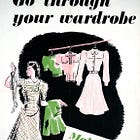Dressing on the Ration: The End of Rationing
Part 3 of a series exploring how clothing rationing transformed British life and fashion during World War 2
This is part 3 of a series about the history of clothing rationing during World War 2 Britain. If you missed the previous editions, please click the links below to read them.
The End of the War & Austerity
Sadly for people living in Britain, the end of the war was not the end of food or clothing rationing. In fact, by VE and VJ days, the amount of clothing coupons someone could rely on had shrunk dramatically. Compared to the introduction of clothes rationing in 1941 when 66 coupons were allotted to the average person per year, the coupon allowance dropped to 24 coupons for eight months between September 1945 and April 1946. Likewise, what those coupons could buy decreased as the government changed the points value of certain times throughout the rationing years.
One reason for this was that Britain was nearly bankrupted by World War 2 having incurred massive debts. Additionally, the economy had not yet recovered and returned to what it had been before the war.
In order to regain Britain’s economic footing, the government kept rationing in place, leading to the period known as the Age of Austerity.
Another challenge that the end of the war presented when it came to clothing was the demobbing of millions of servicemen and women. As they were sent home, men were given a “demob suit” at a demobilization centre. This would usually include:
a double-breasted pinstripe suit or a single-breasted jacket with flannel trousers
Two shirts and collars with collar studs
a tie
shoes
a hat
a raincoat
They would also receive 90 coupons to rebuilt their post-war wardrobe.
Servicewomen who were demobbed usually received coupons and cash.1
The End of Rationing
Restrictions on purchasing clothing in Britain were finally lifted in March 1949, nearly four years after World War 2 ended. This meant that clothing could be purchased without coupons for the first time in eight years.
Harold Wilson, president of the Board of Trade at the time, spoke about the end of the clothing ration in this video for British Pathé.
I think it is important to remember that when Christian Dior’s famous and groundbreaking New Look collection debuted in Paris on February 12, 1947, Britain was still in the depths of rationing. The New Look rejected wartime austerity with its full-skirted silhouettes, and it must have been a breath of fresh air to the French fashion industry which had been so battered during the war. However, it would be two years before those huge, iconic skirts that could require up to 25 yards of fabric could even be imaginable across the English Channel.
My book The Dressmakers of London, a novel about two estranged sisters who are forced back together when they unexpectedly inherit their mother’s London dress shop during World War 2, is now available in print, ebook, and audiobook. Further information is available on my website.
I haven’t yet found further detail about the amounts women would have received. If anyone does have that answer, please don’t hesitate to drop a comment below.






I've really enjoyed these "Dressing on the Ration" articles.
And loved your book!
"Restrictions on purchasing clothing in Britain were finally lifted in March 1941, nearly four years after World War 2 ended." ???